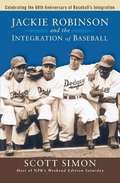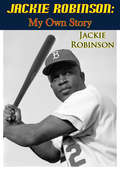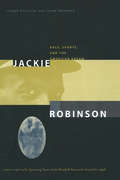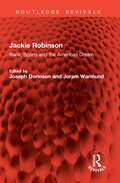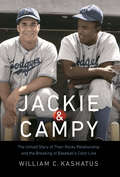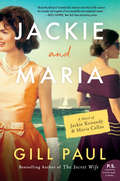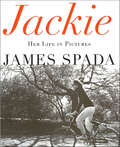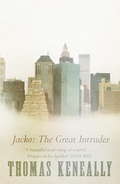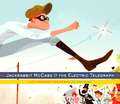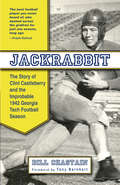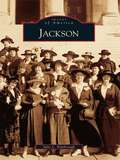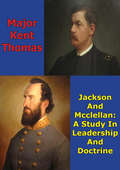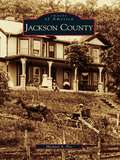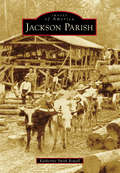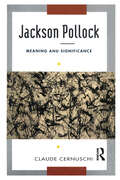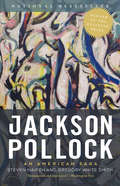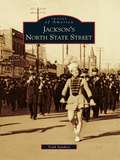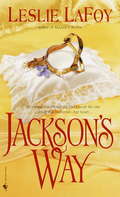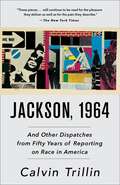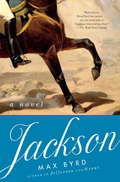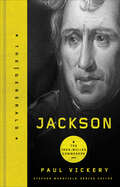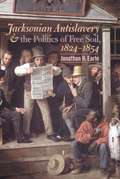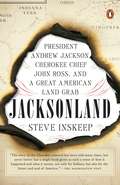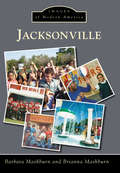- Table View
- List View
Jackie Robinson and the Integration of Baseball
by Scott SimonScott Simon reveals how Robinson's heroism brought the country face-to-face with the question of racial equality. From his days in the army to his ascent to the major leagues, Robinson battled bigotry at every turn. Simon deftly traces the journey of the rookie who became Rookie of the Year, recalling the taunts and threats, the stolen bases and the slides to home plate, the trials and triumphs. Robinson's number, 42, has been retired by every club in major league baseball--in homage to the man who had to hang his first Brooklyn Dodgers uniform on a hook rather than in a locker.
Jackie Robinson: A Biography
by Arnold RampersadThe extraordinary life of Jackie Robinson is illuminated as never before in this full-scale biography by Arnold Rampersad, who was chosen by Jack's widow, Rachel, to tell her husband's story, and was given unprecedented access to his private papers.
Jackie Robinson: My Own Story
by Jackie Robinson Branch Rickey Wendell SmithAutobiography of baseball legend Jackie Robinson, beginning with his athletic career and dealing particularly with baseball and the first step toward equal participation by African Americans in this great sport."I believe that a man's race, color, and religion should never constitute a handicap. The denial to anyone, anywhere, any time of equality of opportunity to work is incomprehensible to me. Moreover, I believe that the American public is not as concerned with a first baseman's pigmentation as it is with the power of his swing, the dexterity of his slide, the gracefulness of his fielding, or the speed of his legs."--From Foreword by Branch Hickey
Jackie Robinson: Race, Sports and the American Dream
by Joseph Dorinson Joram WarmundWith these words, President Clinton contributed to Long Island University's three-day celebration of that momentous event in American history when Robinson became the first African American to play major league baseball. This new book includes presentations from that celebration, especially chosen for their fresh perspectives and illuminating insights.A heady mix of journalism, scholarship, and memory offers a presentation that far transcends the retelling of just another sports story. Readers get a true sense of the social conditions prior to Robinson's arrival in the major leagues and the ripple effect his breakthrough had on the nation. Anecdotes enliven the story and offer more than the usual "larger than life" portrait of Robinson.A melange of contributors from the sports world, academia, and journalism, some of Robinson's contemporaries, Dodger fans, and historians of the era, all sharing a passion for baseball, reflect on issues of sports, race, and the dramatic transformation of the American social and political scene in the last fifty years. In addition to the editors, the list of authors includes Peter Golenbock, one of America's preeminent sports biographers and author of Bums: The Brooklyn Dodgers, 1947-1957, Tom Hawkins, the first African-American to star in basketball at Notre Dame and currently Vice-President for Communications of the Los Angeles Dodgers, Bill Mardo a former writer for the New York Daily Worker, Roger Rosenblatt, teacher at the Southampton Campus of Long Island University, and author of numerous articles, plays, and books, Peter Williams, author of a study of sports myth, The Sports Immortals, and Samuel Regalado, author of Viva Baseball!: LatinMajor Leaguers and Their Special Hunger.
Jackie Robinson: Race, Sports and the American Dream (Routledge Revivals)
by Joseph Dorinson Joram WarmundThere are defining moments in the life of a nation when a single individual can shape events for generations to come. For America, the spring of 1947 was such a moment, and Jackie Robinson was the man who made the difference." With these words, President Clinton contributed to Long Island University's three-day celebration of that momentous event in American history when Robinson became the first African American to play major league baseball.First published in 1998, Jackie Robinson: Race, Sports and the American Dream includes presentations from that celebration, especially chosen for their fresh perspectives and illuminating insights. A heady mix of journalism, scholarship, and memory offers a presentation that far transcends the retelling of just another sports story. Readers get a true sense of the social conditions prior to Robinson's arrival in the major leagues and the ripple effect his breakthrough had on the nation. Anecdotes enliven the story and offer more than the usual "larger than life" portrait of Robinson.A mélange of contributors from the sports world, academia, and journalism, some of Robinson's contemporaries, Dodger fans, and historians of the era, all sharing a passion for baseball, reflect on issues of sports, race, and the dramatic transformation of the American social and political scene in the last fifty years. This book is a must read for anyone interested in American Sports history and sports in general.
Jackie and Campy: The Untold Story of Their Rocky Relationship and the Breaking of Baseball's Color Line
by William C. KashatusAs star players for the 1955 World Champion Brooklyn Dodgers, and prior to that as the first black players to be candidates to break professional baseball’s color barrier, Jackie Robinson and Roy Campanella would seem to be natural allies. But the two men were divided by a rivalry going far beyond the personality differences and petty jealousies of competitive teammates. Behind the bitterness were deep and differing beliefs about the fight for civil rights. Robinson, the more aggressive and intense of the two, thought Jim Crow should be attacked head-on; Campanella, more passive and easygoing, believed that ability, not militancy, was the key to racial equality. Drawing on interviews with former players such as Monte Irvin, Hank Aaron, Carl Erskine, and Don Zimmer, Jackie and Campy offers a closer look at these two players and their place in a historical movement torn between active defiance and passive resistance. William C. Kashatus deepens our understanding of these two baseball icons and civil rights pioneers and provides a clearer picture of their time and our own.
Jackie and Maria: A Novel of Jackie Kennedy & Maria Callas
by Gill PaulFrom the #1 bestselling author of The Secret Wife comes a story of love, passion, and tragedy as the lives of Jackie Kennedy and Maria Callas are intertwined—and they become the ultimate rivals, in love with the same man.The President's Wife; a Glamorous Superstar; the rivalry that shook the world... Jackie Kennedy was beautiful, sophisticated, and contemplating leaving her ambitious young senator husband. Life in the public eye with an overly ambitious--and unfaithful—man who could hardly be coaxed to return from a vacation after the birth of a stillborn child was breaking her spirit. So when she's offered a holiday on the luxurious yacht owned by billionaire Ari Onassis, she says yes...to a meeting that will ultimately change her life. Maria Callas is at the height of her operatic career and widely considered to be the finest soprano in the world. And then she's introduced to Aristotle Onassis, the world’s richest man and her fellow Greek. Stuck in a childless, sexless marriage, and with pressures on all sides from opera house managers and a hostile press, she finds her life being turned upside down by this hyper-intelligent and impeccably charming man... Little by little, Maria’s and Jackie’s lives begin to overlap, and they come closer and closer until everything they know about the world changes on a dime.
Jackie: Her Life in Pictures
by James SpadaFrom the New York Times–bestselling author: “These 251 black and white photos capture her well-lived, much-photographed life in adoring detail.” —Publishers WeeklyA legendary life shown in rare, mostly never before published photographs. Arguably the most famous woman of the twentieth century, certainly one of its most photographed, Jacqueline Bouvier Kennedy Onassis lived an astonishing life; her popularity and the fascination she held for people the world over during her nearly sixty years in the spotlight can hardly be overestimated. And while that has led to a number of books about her, none has told her life story in the way this one does—entirely in photographs, from birth to death, with lively, anecdotal extended captions.Of the 251 photographs in Jackie: Her Life in Pictures, 165 have never been published, 58 have rarely been published (in newspapers or magazines but never in book form), and 28 are inescapable images that have been seared into the memories of everyone. Together with the text by James Spada that runs alongside them, these pictures tell the story of an American life that became legendary even while it was being lived, a story that will speak afresh to the hearts of all Americans.“In this sophisticated, beautifully produced work, he has chosen to let the photos of Jackie do all the talking. And she tells everything, with the help of his insightful and detailed captions to help propel the story . . . Spada has much to be proud of.” —The Austin Chronicle“This cradle-to-grave retrospective of one of the 20th century's most public lives does justice to its subject as well as its readers.” —The Advocate
Jacko: The Great Intruder
by Thomas KeneallyWith his genial air of an Australian innocent, Jacko Emptor is New York's most public trespasser, invading people's homes at random for a live television show. Until he undertakes the televised hunt for a missing woman and, finally, meets a barrier even he will not transgress. The dramatic tale of Jacko's exploits probes the dubious ethics behind some television programmes and illuminates how a civilized society can harbour appalling evil.
Jackrabbit McCabe and the Electric Telegraph
by Leo Espinosa Lucy Margaret RozierThe fastest man in the West meets his match in this deliciously clever original tall tale--perfect for the Common Core classroom. With his extra-long legs, Jackrabbit McCabe can outrun anything on the American frontier: horses, trains, and even twisters. So of course, everyone in the town of Windy Flats always counts on his speed when a message has to get out fast. Then something new comes to town: the telegraph, which can send Morse code messages with the speed of electricity. At first, no one believes the newfangled contraption can deliver a message quicker than Jackrabbit. . . . But in a race between man and machine, who will be left in the dust? An author's note includes information about the invention of the telegraph, a Morse code key, and a riddle written in Morse code for kids to transcribe."A strikingly accomplished debut.... A terrific tall tale about the costs and opportunities of technology." --Publishers Weekly, Starred"Good, quick-moving fun. Kids may marvel that communication existed before the telephone and Internet." --Kirkus ReviewsFrom the Hardcover edition.
Jackrabbit: The Story Of Clint Castleberry And The Improbable 1942 Georgia Tech Season
by Bill ChastainHe ran like a crazed jackrabbit, according to one awe-struck sportswriter. Clint Castleberry was already an Atlanta-area football sensation when he arrived at Georgia Tech in 1942, and in one meteoric college season he became a national sports hero as well. He was the first college freshman ever to be voted All-American. At least one Heisman Trophy was all but certain. Though weighing just 155 pounds, he seemed destined to become one of the greatest tailbacks in college football history. But then World War II intervened, and Castleberry became, instead, another young man whose destiny was cut short. His #19 is the only number ever retired in the illustrious history of Georgia Tech football. Bill Chastain weaves Clint Castleberry’s story around other legends of Georgia Tech football--including John Heisman, William Alexander, and Bobby Dodd—to create a glorious portrait of a proud football tradition and America’s Greatest Generation.
Jackson
by Julie L. KimbroughJackson celebrates the history of Mississippi's capital city with more than 200 photographs from the Mississippi Department of Archives and History, the National Archives, and university collections. From its start as a settlement on LeFleur's Bluff overlooking the Pearl River to its present-day position as one of the leading cities of the New South, Jackson's history is one of change, colorful characters, and a uniquely Southern atmosphere. Beginning with a tour of one of the city's oldest and best-known streets, Jackson features the work of outstanding local photographers and combines detailed historical narratives with entertaining stories about ordinary Jacksonians. From the club president who saved a magnolia tree by staging a protest in its branches to the photographer who opened his first studio in a tent, this compelling visual history revisits familiar landmarks and people from Jackson's past.
Jackson And McClellan: A Study In Leadership And Doctrine
by Major Kent ThomasCentral to the waging of war at the tactical level is the interplay between leadership and doctrine. Within a doctrinal context, the Army must develop leaders capable of winning the next war. This study examines the balance between leadership and doctrine and identifies the characteristics that distinguish the great leader from the also-ran.The vehicle for this examination is a comparison of two American Civil war generals, Stonewall Jackson and George McClellan. Purporting to support the same doctrine, the two men achieved remarkably dissimilar results on the battlefield. This analysis demonstrates that the reasons for that difference lay primarily in the realm of leadership rather than in the implementation of doctrine, and identifies the leadership principles key to success at the tactical level of war.
Jackson County (Images of America)
by Michael PoeOn October 28, 1770, George Washington entered present-day Jackson County by traveling south down the Ohio River. The Sachem tribe camped with Washington's party and expressed a desire to barter with the Virginia traders. Washington made extensive notes of the terrain, animals, and timber. By 1772, Washington had patents on more than 6,800 acres in Jackson County. This led to the Ohio River being the source of trade, entertainment, and survival early in the history of Jackson County. Named after the seventh president of the United States, Andrew Jackson, Jackson County was established by an act of the Virginia General Assembly on March 1, 1831, out of parts of Mason, Kanawha, and Wood Counties. The terrain is sandy with fertile bottomlands along the Ohio River and gently rolling hills toward the east. Ripley is the county seat, situated in the central part of the county, and is named in honor of Harry Ripley, who drowned in Big Mill Creek in 1830.
Jackson Parish
by Katherine Smith RowellJackson Parish was formed in 1845, and settlers traversed treacherous territories, thick brush, and waterways to take advantage of cheap government land. The pioneers--mostly farmers--transformed a vastly forested area into several thriving communities. The Tremont Lumber Company founded the mill towns of Eros and Chatham in the early 20th century. Simultaneously, the Arkansas Southern Railroad's arrival brought settlements to Quitman and Ansley. In 1903, Jonesboro was officially declared a town after it reached 1,000 residents; eight years later, it claimed the parish seat from Vernon, which had held that title since 1846. A new courthouse was built in Jonesboro the following year. Weston, Stovall, Walker, and Midway provided churches and schools for a growing population. Hodge staked claim in the paper and packaging industries by the 1920s, and the 1940 song "You Are My Sunshine" by Jimmie Davis, a Beech Springs native and Louisiana's "Singing Governor," forever changed the way Jackson Parish would be remembered. These memories, and more, are chronicled in Images of America: Jackson Parish.
Jackson Pollack: Meaning And Significance
by Claude CernuschiDesigned to help students and interested general readers to interpret the abstract expressionist paintings of Jackson Pollock, this survey of Pollock's life and art provides insight into the origins and meanings of individual works and analyzes the influences upon Pollock. Also included are discussions of the many issues raised by Pollock's work above and beyond his intentions, and how they intersected with the work of his contemporaries as well as other intellectual currents of the time.
Jackson Pollock
by Steven Naifeh Gregory White SmithJackson Pollock was more than a great artist, he was a creative force of nature. He changed not only the course of Western art, but our very definition of "art. " He was the quintessential tortured genius, an American Vincent van Gogh, cut from the same unconforming cloth as his contemporaries Ernest Hemingway and James Dean--and tormented by the same demons; a "cowboy artist" who rose from obscurity to take his place among the titans of modern art, and whose paintings now command millions of dollars. Here, for the first time, is the life behind that extraordinary achievement--the disjointed childhood, the sibling rivalry, the sexual ambiguity, and the artistic frustration out of which both artist and art developed. Based on more than 2,000 interviews with 850 people, Jackson Pollock is the first book to explore the life of a great artist with the psychological depth that marks the best biographies of literary and political figures. In eight years of research the authors have uncovered previously unknown letters and documents, gained access to medical and psychiatric records, and interviewed scores of the artist's friends and acquaintances whose stories had never been told. They were also the first biographers in twenty years to benefit from the cooperation of Pollock's widow, Lee Krasner. The results of these unprecedented efforts lie before you: a rich, sprawling, landmark biography of one of the most compelling figures in all of American culture; a brilliant, explosive "portrait of the artist," intimately detailed, abundantly illustrated (with more than 200 photographs from Pollock's life and work, many of them never before published), and filled with new information and new insights. In a style as richly textured, engrossing, and poignant as the best of contemporary literature, Steven Naifeh and Gregory White Smith give us the family crucible out of which the artist and his art emerged. Beginning with Jackson's birth on a sheep ranch in Wyoming, we follow the Pollock family on a relentless trek across the American West, as their dreams of a better life somewhere else are repeatedly frustrated. We see the young Jack Pollock as a struggling art student in New York, escaping into drunken rages or throwing himself into the Hudson River in one of several attempts at suicide. Later, we see Pollock, by turns, gently affectionate and outrageously cruel, creatively bankrupt and heroically productive. We see him alternately fascinated and intimidated by his contemporaries: Clement Greenberg, Franz Kline, Willem de Kooning, Robert Motherwell, Barnett Newman, Harold Rosenberg, Clyfford Still, Tennessee Williams. We see him enter into a tumultuous marriage with the painter Lee Krasner, creating a powerful alliance that will lead first to triumph, then to decline, and finally to death when, with his mistress at his side, Pollock smashes his car into a tree. But Jackson Pollock is more than the epic story of a tormented man and his sublime art, it is also a compulsively readable, sweeping saga of America's cultural coming of age. From frontier Iowa to the dust bowl of Arizona, from the twilight of the Wild West to the desolation of Depression-era New York, from the excitement and experimentation of the Mexican muralists to the fanfare of the Surrealists' visit to America, from the arts projects of the WPA to the explosion of interest and money that marked the beginning of the modern art world, Pollock's story unfolds against the dramatic landscape of American history. Here then is a definitive record of the journey of an artist, filled with piercing psychological insights, that brings us to a truer understanding of the power and pathos of creative genius. "Monumental and impressive. " "Washington Post" "For once, with this intense, engrossing, and indeed brilliant work, we have a biography that justifies its length. Seldom have the history of an artist,"
Jackson's North State Street (Images of America)
by Todd SandersSince the mid-19th and early 20th centuries, Jackson's North State Street has been home to some of the capital city's major architectural landmarks. North State Street was bordered by stately homes of many different styles and periods, from rather simple antebellum cottages, to grand Greek Revival, elaborate Queen Anne, and elegant Colonial Revival and neoclassical mansions, as well as impressive institutional buildings and churches. However, beginning in the early years of the Great Depression, many of these stately homes and buildings were lost, replaced by apartments, parking lots, and commercial buildings. Through the images in this book, those who never witnessed first hand the majesty of Jackson's North State Street will be able to gain some insight into what has been lost and truly appreciate what remains. For those who remember what North State Street was, this book will be a chance to revisit and reminisce about that lost era.
Jackson's Way
by Leslie LafoyHe owned everything she had except the one thing that mattered -- her heart....Lindsay MacPhaull took one look at the tall, dark, handsome Texan in her office doorway and knew that she was in trouble. And, as always, she was right. Jackson Stennett had come to New York City to deliver the news that her long-absent father was dead, and that everything -- from her struggling business to the very clothes on her back -- now belonged to him. Jackson Stennett was no stranger to tragedy or to the loss of love. But the minute he lays eyes on the seductive and headstrong Lindsay, the walls begin to crumble. He has sixty days to resist her charms and sell off the business. Lindsay has sixty days to stop him from destroying her world. But when acts of sabotage and shadowy threats emerge, they have no choice but to join forces in a sizzling alliance against a terrifying, unseen enemy who would destroy them both.... and bring out an intense passion and desire neither can deny.
Jackson, 1964: And Other Dispatches from Fifty Years of Reporting on Race in America
by Calvin TrillinFrom bestselling author and beloved New Yorker writer Calvin Trillin, a deeply resonant, career-spanning collection of articles on race and racism, from the 1960s to the present In the early sixties, Calvin Trillin got his start as a journalist covering the Civil Rights Movement in the South. Over the next five decades of reporting, he often returned to scenes of racial tension. Now, for the first time, the best of Trillin's pieces on race in America have been collected in one volume. In the title essay of Jackson, 1964, we experience Trillin's riveting coverage of the pathbreaking voter registration drive known as the Mississippi Summer Project--coverage that includes an unforgettable airplane conversation between Martin Luther King, Jr., and a young white man sitting across the aisle. ("I'd like to be loved by everyone," King tells him, "but we can't always wait for love.") In the years that follow, Trillin rides along with the National Guard units assigned to patrol black neighborhoods in Wilmington, Delaware; reports on the case of a black homeowner accused of manslaughter in the death of a white teenager in an overwhelmingly white Long Island suburb; and chronicles the remarkable fortunes of the Zulu Social Aid & Pleasure Club, a black carnival krewe in New Orleans whose members parade on Mardi Gras in blackface. He takes on issues that are as relevant today as they were when he wrote about them. Excessive sentencing is examined in a 1970 piece about a black militant in Houston serving thirty years in prison for giving away one marijuana cigarette. The role of race in the use of deadly force by police is highlighted in a 1975 article about an African American shot by a white policeman in Seattle. Uniting all these pieces are Trillin's unflinching eye and graceful prose. Jackson, 1964 is an indispensable account of a half-century of race and racism in America, through the lens of a master journalist and writer who was there to bear witness.Advance praise for Jackson, 1964 "An exceptional collection [from] master essayist Trillin . . . exposing through perceptive observations and nuanced humor the insidious nature of discriminatory practices."--Booklist (starred review)"Trillin, a regular contributor to the New Yorker since 1963, collects his insights and musings on race in America in previously published essays from over fifty years of reporting. . . . What's shocking is how topical and relatively undated many of these essays seem today."--Publishers Weekly (starred review)"The author of some thirty titles, Trillin revisits the last half-century's racial struggles in various regions of the country, and readers are likely to come away thinking, 'so much has not really changed all that much.' . . . Haunting pieces that show how our window on the past is often a mirror."--Kirkus Reviews Praise for Calvin Trillin"That rarity, reportage as art."--The New York Times "[A writer] of painterly, impeccably crafted journalism."--People "Trillin is perhaps the finest reporter in America."--The Miami Herald "If Truman Capote invented the nonfiction novel, as he claimed, and Norman Mailer devised variations on it, Trillin has perfected the nonfiction short story; moreover, his craftsmanship can contend with that of either Capote or Mailer at their best."--Kirkus ReviewsFrom the Hardcover edition.
Jackson: A Novel
by Max ByrdIn this sweeping, marvelously written novel, Max Byrd, the celebrated author of Jefferson and Grant, presents a superb portrait of Andrew Jackson, a President remembered for his strong will and tempestuous nature--and regarded as "the most dangerous man in America" by none other than Thomas Jefferson. He became a legend during the War of 1812. He was a slave owner, land speculator, and Indian fighter. He stole another man's wife, murdered men in duels, and ordered military executions. But Andrew Jackson was also an impassioned supporter of universal suffrage and an ardent believer in the will of the people. Here the story of our controversial seventh President is told from a variety of viewpoints, including that of a young writer named David Chase who discovers, on the eve of the presidential election, a secret that could change the future of the nation. Along the way, readers encounter such notable figures as John Quincy Adams, Aaron Burr, and Sam Houston, and bear witness to an America in transition--and a man as unpredictable as democracy itself. "Max Byrd's historical novels about the third and seventh presidents bring both men alive in ways that only a literary imagination can."--George F. Will, The Washington Post "With Jackson, [Max] Byrd has vaulted . . . into the front rank of American historical novelists."--The Wall Street Journal "Vivid and compelling . . . a convincing and intriguing portrait of Jackson as he might have been."--The Plain Dealer "Full of action, emotion, and insight, Max Byrd's Jackson deserves to stand with the finest works of historical fiction."--San Francisco Chronicle "Grounded in excellent, detailed historical research, Byrd paints a rich, multilayered portrait."--Chicago TribuneFrom the Trade Paperback edition.
Jackson: The Iron-Willed Commander (The Generals Series)
by Paul VickeryA gripping account of the man who emerged as a national hero through his military successes—and became the seventh President of the United States.Orphan. Frontiersman. President. The rise of Andrew Jackson to the highest office in America has become a legend of leadership, perseverance, and ambition. Central to Jackson’s historic climb—long before the White House—was his military service. Scarred permanently as a child by the sword of a British soldier, Jackson grew into an unwavering leader, a general whose charisma and sheer force of personality called to mind those of George Washington a generation earlier.As commander of the Tennessee militia in the War of 1812, Jackson became “Old Hickory,” the indomitable spearhead in a series of bloody conflicts with the Creek on the southwest frontier. Slight of frame with silver hair that seemed to stand on command, Jackson once stood down a mutinous brigade as an army of one. Then came New Orleans. Author Paul Vickery chronicles Jackson’s defining battle and the decisions a single, impassioned commander made to ensure a growing nation could, once and for all, be free of British might. The hero of New Orleans infused America, for the first time, with a sense of nationalism.Jackson was decisive and unforgiving, a commander firmly in his element. In his own words, “One man with courage makes a majority.” The lessons of one extraordinary general endure.
Jacksonian Antislavery and the Politics of Free Soil, 1824-1854
by Jonathan H. EarleTaking our understanding of political antislavery into largely unexplored terrain, Jonathan H. Earle counters conventional wisdom and standard historical interpretations that view the ascendance of free-soil ideas within the antislavery movement as an explicit retreat from the goals of emancipation or even as an essentially proslavery ideology. These claims, he notes, fail to explain free soil's real contributions to the antislavery cause: its incorporation of Jacksonian ideas about property and political equality and its transformation of a struggling crusade into a mass political movement.Democratic free soilers' views on race occupied a wide spectrum, but they were able to fashion new and vital arguments against slavery and its expansion based on the party's long-standing commitment to egalitarianism and hostility to centralized power. Linking their antislavery stance to a land-reform agenda that pressed for free land for poor settlers in addition to land free of slavery, Free Soil Democrats forced major political realignments in New York, New Hampshire, Massachusetts, and Ohio. Democratic politicians such as David Wilmot, Marcus Morton, John Parker Hale, and even former president Martin Van Buren were transformed into antislavery leaders. As Earle shows, these political changes at the local, state, and national levels greatly intensified the looming sectional crisis and paved the way for the Civil War.
Jacksonland: President Andrew Jackson, Cherokee Chief John Ross, and a Great American Land Grab
by Steve InskeepJacksonland is the thrilling narrative history of two men--President Andrew Jackson and Cherokee chief John Ross--who led their respective nations at a crossroads of American history. Five decades after the Revolutionary War, the United States approached a constitutional crisis. At its center stood two former military comrades locked in a struggle that tested the boundaries of our fledgling democracy. Jacksonland is their story. One man we recognize: Andrew Jackson--war hero, populist, and exemplar of the expanding South--whose first major initiative as president instigated the massive expulsion of Native Americans known as the Trail of Tears. The other is a half-forgotten figure: John Ross--a mixed-race Cherokee politician and diplomat--who used the United States' own legal system and democratic ideals to oppose Jackson. Representing one of the Five Civilized Tribes who had adopted the ways of white settlers--cultivating farms, publishing a newspaper in their own language, and sending children to school--Ross championed the tribes' cause all the way to the Supreme Court. He gained allies like Senator Henry Clay, Chief Justice John Marshall, and even Davy Crockett. In a fight that seems at once distant and familiar, Ross and his allies made their case in the media, committed civil disobedience, and benefited from the first mass political action by American women. Their struggle contained ominous overtures of later events like the Civil War and set the pattern for modern-day politics. At stake in this struggle was the land of the Five Civilized Tribes. In shocking detail, Jacksonland reveals how Jackson, as a general, extracted immense wealth from his own armies' conquest of native lands. Later, as president, Jackson set in motion the seizure of tens of millions of acres--"Jacksonland"--in today's Deep South. Jacksonland is the work of renowned journalist Steve Inskeep, cohost of NPR's Morning Edition, who offers here a heart-stopping narrative masterpiece, a tragedy of American history that feels ripped from the headlines in its immediacy, drama, and relevance to our lives. Harrowing, inspiring, and deeply moving, Inskeep's Jacksonland is the story of America at a moment of transition, when the fate of states and nations was decided by the actions of two heroic yet tragically opposed men. CANDICE MILLARD, author of Destiny of the Republic and The River of Doubt"Inskeep tells this, one of the most tragic and transformative stories in American history, in swift, confident, colorful strokes. So well, and so intimately, does he know his subject that the reader comes away feeling as if Jackson and Ross's epic struggle for the future of their nations took place yesterday rather than nearly two hundred years ago." From the Hardcover edition.
Jacksonville
by Barbara Mashburn Brianna MashburnRecognized throughout the state as Arkansas's fastest-growing city, Jacksonville evolved from a settlement surrounding the railroad depot, eventually incorporating as a town in 1941. The population soared when the exceedingly large ordnance plant was built during World War II. The plant's footprint included much of present-day Jacksonville and employed upwards of 20,000 people. The migration northward from larger cities to this bustling suburban town has created an astounding contemporary history. With the advent of the nuclear age in 1955, Jacksonville took its place as a member of the Strategic Air Command family with its neighbor, the Little Rock Air Force Base. This book presents the town's history from the 1960s forward and showcases local accomplishments from the last 50 years.
